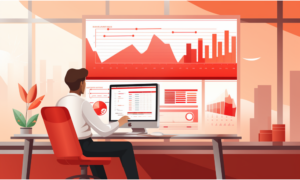Workforce planning post-COVID and beyond
- 6 Min Read
As the pandemic subsides, many organizations don’t know which way to turn when it comes workforce planning. The natural response is to return to the office, but is this the most effective solution? With the help of industry experts Becky Thoseby, Ministry of Justice UK, and Chuck Heaton, HRD Thought Leader, we took a closer look.
- Author: Sam Alberti
- Date published: Aug 24, 2020
- Categories

In many corners of the world, the coronavirus pandemic is finally drawing to a conclusion. New Zealand, for instance, reported just three new cases of the virus on August 23, and recently saw a period of 101 consecutive days with no new cases found.
In large part, this will constitute the end of the corporate conundrum that has blighted the working world for nearly half a year. However, from a certain perspective, the greatest conundrum is still yet to come.
This is of course the dilemma of how to conduct a return to work. Needless to say, 2020’s workspace is practically unrecognizable (46.6% of the UK’s working population completed some form of remote work in April 2020) and shifting away from this will be a complex and large-scale operation.
Complicating things further, however, is the fact that many have prospered under these circumstances. Athletic apparel retailer Lululemon, for instance, has seen its stock price soar by 45% in 2020 so far. Similarly, Gymshark, another fitness clothing retailer, recently became the UK’s latest £1bn brand.
This begs the question: is a ‘return’, in the physical sense, even necessary?
Naturally, opinions on this will be divided, but regardless, one irrefutable principle remains: efficiency, employee satisfaction and productivity are paramount, and must be front-of-mind for HR leaders during this next phase of workforce planning.
With the help of some industry experts, we examined this issue a little closer.
The next phase of workforce planning – what must remain?
This, we believe, is the first question HR leaders should be asking themselves when considering next steps for the organization’s workspace.
So long as core organizational principles and processes remain intact, the physical aspect is arguably a secondary issue. To gain a clearer understanding of how this concept can be actioned, we sought the views of two seasoned professionals: Becky Thoseby, Ministry of Justice UK’s head of workplace wellbeing, and Chuck Heaton, HRD Thought Leader and people & culture expert.
Heaton said: “The collaborative element is vital, wherever it takes place. The ability to share ideas, communicate and give feedback is paramount.
“This should also help build resilience as a result. We need to keep people organized and engaged, give them chance to breath and get ready to end the fiscal year in a positive way.”
Concurring, Thoseby said: “We need to move to a mindset where we are focusing on what people produce rather than where the are located or how many hours they work.
“We don’t pay people to sit in front of a screen for ‘x’ number of hours for we? It’s to produce something, manage risk, solve problems, generate ideas, lead others, and so on. As long at this is still reasonably attainable, location should be an afterthought.”
What good will this do the organization?
When it comes to workforce planning in 2020, traditions and principles should have no place. Organizations must focus their efforts on what produces the most effective results.
This concept is something that lies at the very center of any organization’s plans for the future of work. With this in mind, Heaton and Thoseby turned their attention to the specifics of how businesses can benefit.
Heaton spoke of balance and happiness as core themes here. He said: “Employees who understand where we are going, what is expected of them, and feel they are trusted, are simply more productive, happy, and therefore positively impact the company’s bottom line.
“Organizations need to start figuring out how to gauge the impact that work is having on families, parents and so on, and implementing some balance. By doing this, leaders can set the tone, and ultimately impact engagement and productivity.”
For many leaders, this concept will immediately ring true. COVID-19 has, to an extent, coincided with the advent of HR’s understanding and appreciation of burnout, and how insidious a phenomenon it really.
A Gallup study even found that 44% of employees reported feeling burnt out at some point, and another found that, among physicians, $4.6bn in costs is amassed each year in the United States as a result of burnout and turnover.
The logical extension of this is that productivity will increase if employees are less stressed and overwhelmed by their work, and Thoseby goes on to echo this sentiment.
“Efficiency is key,” she said. “If people are not doing nugatory work or engaging in activities simply to be recognized or look good, productivity will naturally increase.”
How can leaders implement this and strike the right balance?
In spite of the above, deciphering the most desirable outcome is just the beginning when it comes to workforce planning – the ‘what’ and the ‘why’, you might call it. Ultimately, the ‘how’ is where things get tricky.
Offering a rounded analysis founded in different roles and different industries, Heaton and Thoseby once again interjected, providing a commentary for leaders looking to enact change and strike the right balance.
Heaton first outlined the basic values that must be manifested day-to-day in any working environment. He said: “On a basic level, leaders must ensure that they communicate the company’s vision, values, and strategy, and regularly engage with employees.
“The same applies to trust, and this is crucial in a remote environment. There needs to be a mutual trust, not only insofar as employees will carry out their duties in the way they have been instructed to, but also that leaders can be open, compassionate, and act as an ally.”
Thoseby supplemented this by speaking on the importance of balance in this scenario, and how this can be attained.
She said: “For me it comes back to the simple question: ‘what are people there to do?’ At this point, people’s roles can be broken down into activities, and leaders can consider which of these would be better accomplished if done co-located.
“This is the starting point for thinking about how much physical space is needed, and the type of space needed. And from there, thinking about the proportion of the workforce who might wish to come in frequently because they prefer it.”
Following on from this and offering a final thought, Heaton said: “Leaders need to determine what roles need to be done remotely. At this point, flexible and perhaps rotational schedules can be established.
“This could be key in keeping key talent who want flexibility, considering more part-time opportunities, and ultimately not forcing workers to choose between career and home.”









